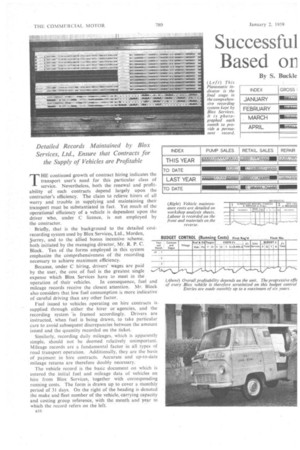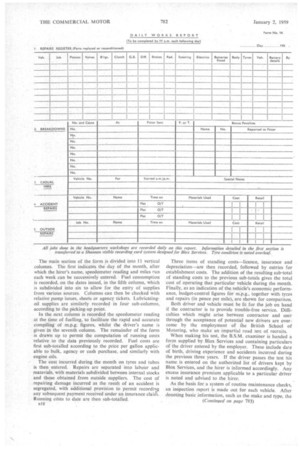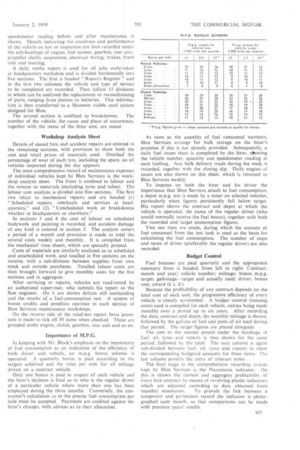Detailed Records Maintained by Blox Services, Ltd., Ensure that Contracts for the Supply of Vehicles are Profitable
Page 50

Page 52

Page 55

If you've noticed an error in this article please click here to report it so we can fix it.
By S. Buckle
THE continued growth of contract hiring indicates the transport user's need for this particular class of service. Nevertheless, both the renewal and profit ability of such contracts depend largely upon the contractor's efficiency. The claim to relieve hirers of all
worry and trouble in supplying and maintaining their transport must be substantiated in fact. Yet much of the operational efficiency of a vehicle is dependent upon the driver who, under C licence, is not employed by the contractor.
Briefly, that is the background to the detailed cost recording system used by Blox Services, Ltd., Morden, surrey, and to the allied bonus incentive scheme, both initiated by the managing director, Mr. R. P. C. Block. Ten of the forms employed in this system emphasize the comprehensiveness of the recording necessary to achieve maximum efficiency.
Because, under C hiring, drivers' wages are paid by the user, the cost of fuel is the greatest single expense which Blox Services have to meet in the operation of their vehicles. In consequence, fuel and mileage records receive the closest attention. Mr. Block also considers that low fuel consumption is more indicative of careful driving than any other factor.
Fuel issued to vehicles operating on hire contracts is supplied through either the hirer or agencies, and the recording system is framed accordingly. Drivers are instructed, when fuel is being drawn, to take particular Care to avoid subsequent discrepancies between the amount issued and the quantity recorded on the ticket.
Similarly, recording daily mileages, which is apparently simple, should not be deemed relatively unimportant.
Mileage records are a fundamental factor in all types of road transport operation. Additionally, they are the basis of payment in hire contracts. Accurate and up-to-date mileage returns are therefore doubly necessary.
The vehicle record is the basic document on which is entered the initial fuel and mileage data of vehicles on hire from Blox Services, together with corresponding running costs. The form is drawn up to cover a monthly period of 31 days. On the right of the heading is denoted the make and fleet number of the vehicle, carrying capacity and costing group reference, with the month and year to which the record refers on the left.
lT : I
B16 The main section of the form is divided into 11 vertical columns. The first indicates the day of the month, after which the hirer's name, speedometer reading and miles run each week can be successively entered. Fuel consumption is recorded, on the dates issued, in the fifth column, which is subdivided into six to allow for the entry of supplies from various sources. Columns can then be checked with relative pump issues, sheets or agency tickets. Lubricatingoil supplies are similarly recorded in four sub-columns, according to the picking-up point.
In the next column is recorded the speedometer reading at the time of fuelling, to facilitate the rapid and accurate compiling of m.p.g figures. whilst the driver's name is given in the seventh column. The remainder of the form is drawn up to permit the computation of running costs relative to the data previously recorded. Fuel costs are first sub-totalled according to the price per gallon applicable to bulk, agency or cash purchase, and similarly with engine oils.
The cost incurred during the month on tyres and tubes is then entered. Repairs are separated into labour and materials, with materials subdivided between internal stocks and those obtained from outside suppliers. The cost of repairing damage incurred as the result of an accident is segregated, with additional provision to permit recording any subsequent payment received under an insurance claim. Running costs to date are then sub-totalled. Three items of standing costs—licence, insurance and depreciation—are then recorded, followed by entries for establishment costs. The addition of the resulting sub-total of standing costs to the previous sub-totals gives the total cost of operating that particular vehicle during the month. Finally, as an indication of the vehicle's economic performance, budget-control figures for m.p.g., together with tyres and repairs (in pence per mile), are shown for comparison.
Both driver and vehicle must be fit for the job on hand if the contractor is to provide trouble-free service. Difficulties which might arise between contractor and user through the acceptance of potential new drivers are overcome by the employment of the British School of Motoring, who make an impartial road test of recruits.
When making his test, the B.S.M. examiner is handed a form supplied by Blox Services and containing particulars of the driver entered by the employer. These include date of birth, driving experience and accidents incurred during the previous three years. If the driver passes the test his name is entered on the authorized list of drivers kept by Blox Services, and the hirer is informed accordingly. Any excess insurance premium applicable to a particular driver is noted and advised to the hirer.
As the basis for a system of routine maintenance checks, an inspection report is made out for each vehicle. After denoting basic information, such as the make and type, the speedometer reading before and after maintenance is shown, Details indicating the condition and performance of the vehicle on test or inspection are 'thenrecorded under the sub-headings of engine, fuel system, gearbox, rear axle. propeller shafts, suspension, electrical wiring, brakes, front' axle and steering.
A daily works report is used for all jobs undertaken at headquarters workshop and is divided horizontally into five sections. The first is headed "Repairs Register" and in the first two columns the vehicle and type of service to be completed are recorded. Then follow 15 divisions in which can be analysed the replacement or reconditioning of parts, ranging from pistons to batteries. This information is then transferred to a Shannon visible card system designed for Blox.
The second section is confined to breakdowns. The numberof the vehicle, the cause and place of occurrence, together with the name of the fitter sent, are noted.
Workshop Analysis Sheet Details of casual hire and accident repairs are entered in the remaining sections, with provision to show both the cost and retail prices of materials used. Overleaf the percentage of wear of each tyre, including the spare, on all vehicles inspected during the day appears.
The most comprehensive record of maintenance expenses of individual vehicles kept by Blox Services is the workshop analysis sheet The front is confined to labour and the reverse to materials (excluding tyres and tubes). The labour cost analysis is divided into five sections. The first two relate to mechanical repairs and are headed (1) "Scheduled repairs, overhauls and services at headquarters," and (2) "Unscheduled work. or breakdowns whether at headquarters or elsewhere."
In sections 3 and 4 the cost of labour on scheduled bodywork and painting is recorded, and accident damage of any kind is entered in section 5. The analysis covers a period of a month and provision is made to total the several costs weekly and monthly. It is compiled from the mechanics' time sheets, which are specially printed.
Costs of materials are similarly analysed as to scheduled and unscheduled work, and totalled in five sections on the reverse, with a sub-division between supplies from own stock and outside purchases. Totalled labour costs are then brought forward to give monthly costs for the five sections and in aggregate.
After servicing or repairs, vehicles are road-tested by an authorized supervisor, who submits his report to the fleet engineer. On it are shown defects still outstanding and the results of a fuel-consumption test. A system of bonus credits and penalties operates in each section of Blox Services maintenance workshops.
On the reverse side of the road-test report form provision is made to tick off 30 items when checked. These are grouped under engine, clutch, gearbox, rear axle and so on.
Importance of M.P.G.
In keeping with Mr. Block's emphasis on the importance of fuel consumption as an indication of the efficiency of both driver and vehicle, an m.p.g. bonus scheme is operated. A quarterly bonus is paid according to the targets achieved and the rates per mile for all mileage driven on a contract vehicle.
Only one bonus is paid in respect of each vehicle and the hirer's decision is final as to who is the regular driver of a particular vehicle where more than one has been employed during the three months. Conversely, the contractor's calculation as to the precise fuel consumption per mile must be accepted. Payments are credited against the hirer's charges, with advices as to their allocation. As soon as the quantity of fuel consumed warrants, Blox Services arrange for bulk storage on the hirer's premises if this is not already provided. Subsequently, a daily fuel issues sheet is completed by the hirer, sowing the vehicle number, quantity and Speedometer reading at each fuelling. Any bulk delivery made during the week is recorded, together with the closing dip. Daily engine-,m1 issues are also shown on this sheet, which is returned to Blox Services weekly.
To impress on both the hirer and his driver the importance that Blox Services attach to fuel consumption, a depot m.p.g. test is made by a tester on selected vehicles, particularly, when figures persistently fall. below target. His report -shows the contract and depot at which the vehicle is operated, the name of the regular driver (who would normally receive Ihe-fuel bonus), together with both the recorded and target. 'consumption figures.
Two test runs are made; during which the amount of fuel consumed from the test tank is used as the basis for calculating the fuel consumption. The number of stops and name of driver (preferably the regular driver) are also recorded.
Budget Control • Fuel, bonuses are paid quarterly and the appropriate summary form is headed, from left to right: Contract; month and year; vehicle number; mileage; bonus m.p.g. -target; gallonage—target a.nd actually used; driver; bonus rate; award (£ s. d.).
Because the profitability of any contract depends on the total cost of each unit, the progressive efficiency of every vehicle is closely scrutinized. A budget control (running costs) card is compiled for each vehicle, entries being made monthly over a period up to six years. After recording the date, contract and depot, the monthly mileage is shown, followed by the gallons of fuel and pints of oil used during that period. The target figures are placed alongside.
The cost to the nearest pound under the headings of fuel, oil, tyres and repairs is then shown for the same period, followed by the total, The next column is again sub-divided between fuel, oil, tyres and repairs to show the corresponding budgeted amounts for these items. The last column permits the entry of relevant notes.
The anal stage in the comprehensive recording system kept by Blox Services is the Planomatic indicator. On this is shown the current and aggregate profitability of every hire contract by means of revolving plastic indicators which are adjusted according to data obtained from monthly summaries. To provide the link between a temporary and permanent record the indicator is photographed each month, so that comparisons can be made with previous years' results.




































































































